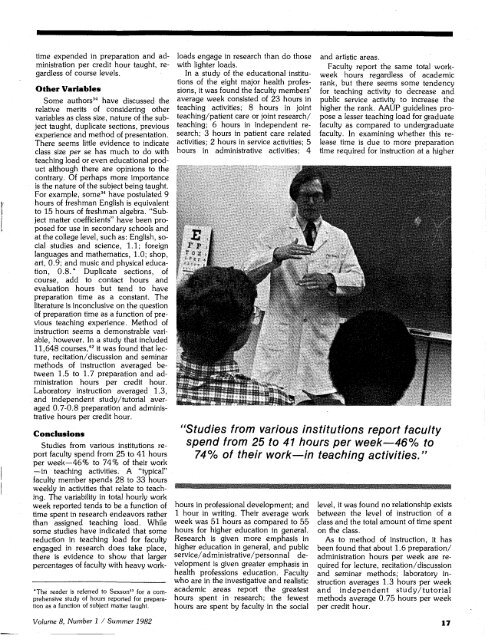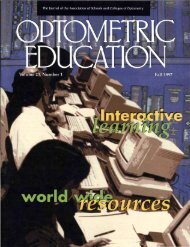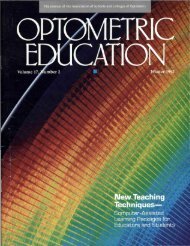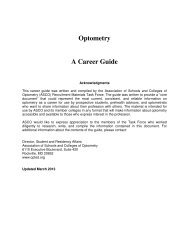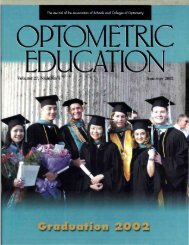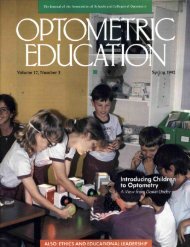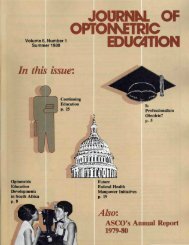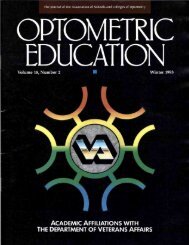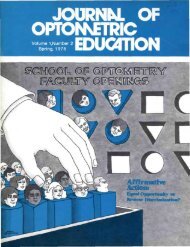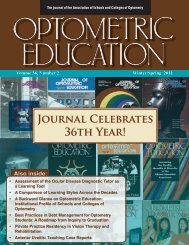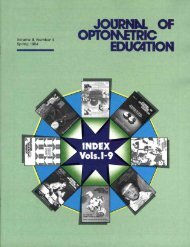JOURNN. OF - Association of Schools and Colleges of Optometry
JOURNN. OF - Association of Schools and Colleges of Optometry
JOURNN. OF - Association of Schools and Colleges of Optometry
You also want an ePaper? Increase the reach of your titles
YUMPU automatically turns print PDFs into web optimized ePapers that Google loves.
time expended in preparation <strong>and</strong> administration<br />
per credit hour taught, regardless<br />
<strong>of</strong> course levels.<br />
Other Variables<br />
Some authors 34 have discussed the<br />
relative merits <strong>of</strong> considering other<br />
variables as class size, nature <strong>of</strong> the subject<br />
taught, duplicate sections, previous<br />
experience <strong>and</strong> method <strong>of</strong> presentation.<br />
There seems little evidence to indicate<br />
class size per se has much to do with<br />
teaching load or even educational product<br />
although there are opinions to the<br />
contrary. Of perhaps more importance<br />
is the nature <strong>of</strong> the subject being taught.<br />
For example, some 34 have postulated 9<br />
hours <strong>of</strong> freshman English is equivalent<br />
to 15 hours <strong>of</strong> freshman algebra. "Subject<br />
matter coefficients" have been proposed<br />
for use in secondary schools <strong>and</strong><br />
at the college level, such as: English, social<br />
studies <strong>and</strong> science, 1.1; foreign<br />
languages <strong>and</strong> mathematics, 1.0; shop,<br />
art, 0.9; <strong>and</strong> music <strong>and</strong> physical education,<br />
0.8. * Duplicate sections, <strong>of</strong><br />
course, add to contact hours <strong>and</strong><br />
evaluation hours but tend to have<br />
preparation time as a constant. The<br />
literature is inconclusive on the question<br />
<strong>of</strong> preparation time as a function <strong>of</strong> previous<br />
teaching experience. Method <strong>of</strong><br />
instruction seems a demonstrable variable,<br />
however. In a study that included<br />
11,648 courses, 42 it was found that lecture,<br />
recitation/discussion <strong>and</strong> seminar<br />
methods <strong>of</strong> instruction averaged between<br />
1.5 to 1.7 preparation <strong>and</strong> administration<br />
hours per credit hour.<br />
Laboratory instruction averaged 1.3,<br />
<strong>and</strong> independent study/tutorial averaged<br />
0.7-0.8 preparation <strong>and</strong> administrative<br />
hours per credit hour.<br />
Conclusions<br />
Studies from various institutions report<br />
faculty spend from 25 to 41 hours<br />
per week—46% to 74% <strong>of</strong> their work<br />
—in teaching activities. A "typical"<br />
faculty member spends 28 to 33 hours<br />
weekly in activities that relate to teaching.<br />
The variability in total hourly work<br />
week reported tends to be a function <strong>of</strong><br />
time spent in research endeavors rather<br />
than assigned teaching load. While<br />
some studies have indicated that some<br />
reduction in teaching load for faculty<br />
engaged in research does take place,<br />
there is evidence to show that larger<br />
percentages <strong>of</strong> faculty with heavy work-<br />
*The reader is referred to Sexson 43 for a comprehensive<br />
study <strong>of</strong> hours reported for preparation<br />
as a function <strong>of</strong> subject matter taught.<br />
loads engage in research than do those<br />
with lighter loads.<br />
In a study <strong>of</strong> the educational institutions<br />
<strong>of</strong> the eight major health pr<strong>of</strong>essions,<br />
it was found the faculty members'<br />
average week consisted <strong>of</strong> 23 hours in<br />
teaching activities; 8 hours in joint<br />
teaching/patient care or joint research/<br />
teaching; 6 hours in independent research;<br />
3 hours in patient care related<br />
activities; 2 hours in service activities; 5<br />
hours in administrative activities; 4<br />
*<br />
'?ff<br />
I<br />
<strong>and</strong> artistic areas.<br />
Faculty report the same total workweek<br />
hours regardless <strong>of</strong> academic<br />
rank, but there seems some tendency<br />
for teaching activity to decrease <strong>and</strong><br />
public service activity to increase the<br />
higher the rank. AAUP guidelines propose<br />
a lesser teaching load for graduate<br />
faculty as compared to undergraduate<br />
faculty. In examining whether this release<br />
time is due to more preparation<br />
time required for instruction at a higher<br />
"Studies from various institutions report faculty<br />
spend from 25 to 41 hours per week—46% to<br />
74% <strong>of</strong> their work—in teaching activities."<br />
hours in pr<strong>of</strong>essional development; <strong>and</strong><br />
1 hour in writing. Their average work<br />
week was 51 hours as compared to 55<br />
hours for higher education in general.<br />
Research is given more emphasis in<br />
higher education in general, <strong>and</strong> public<br />
service/administrative/personnal development<br />
is given greater emphasis in<br />
health pr<strong>of</strong>essions education. Faculty<br />
who are in the investigative <strong>and</strong> realistic<br />
academic areas report the greatest<br />
hours spent in research; the fewest<br />
hours are spent by faculty in the social<br />
level, it was found no relationship exists<br />
between the level <strong>of</strong> instruction <strong>of</strong> a<br />
class <strong>and</strong> the total amount <strong>of</strong> time spent<br />
on the class.<br />
As to method <strong>of</strong> instruction, it has<br />
been found that about 1.6 preparation/<br />
administration hours per week are required<br />
for lecture, recitation/discussion<br />
<strong>and</strong> seminar methods; laboratory instruction<br />
averages 1.3 hours per week<br />
<strong>and</strong> independent study/tutorial<br />
methods average 0.75 hours per week<br />
per credit hour.<br />
Volume 8, Number 1 / Summer 1982 17


